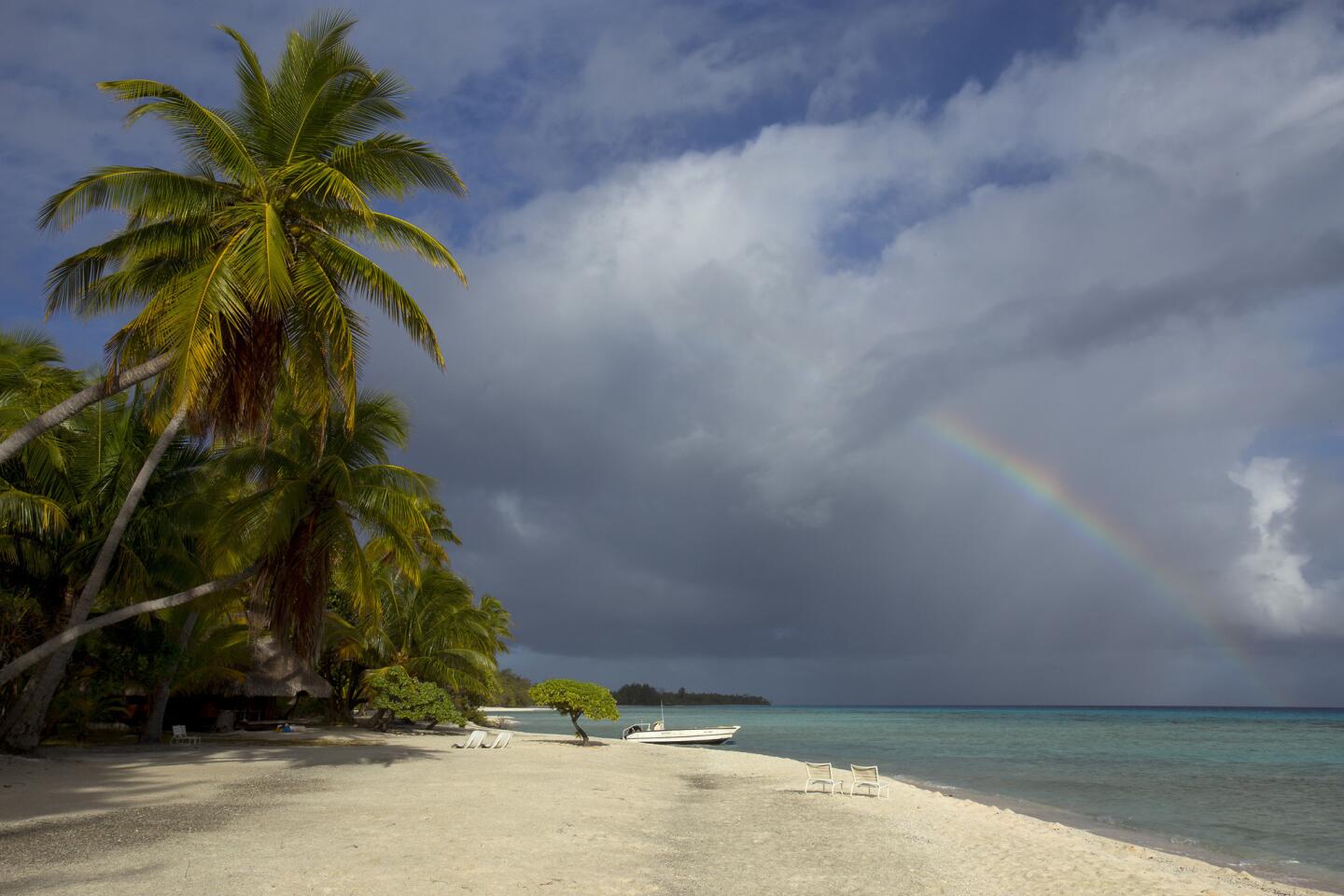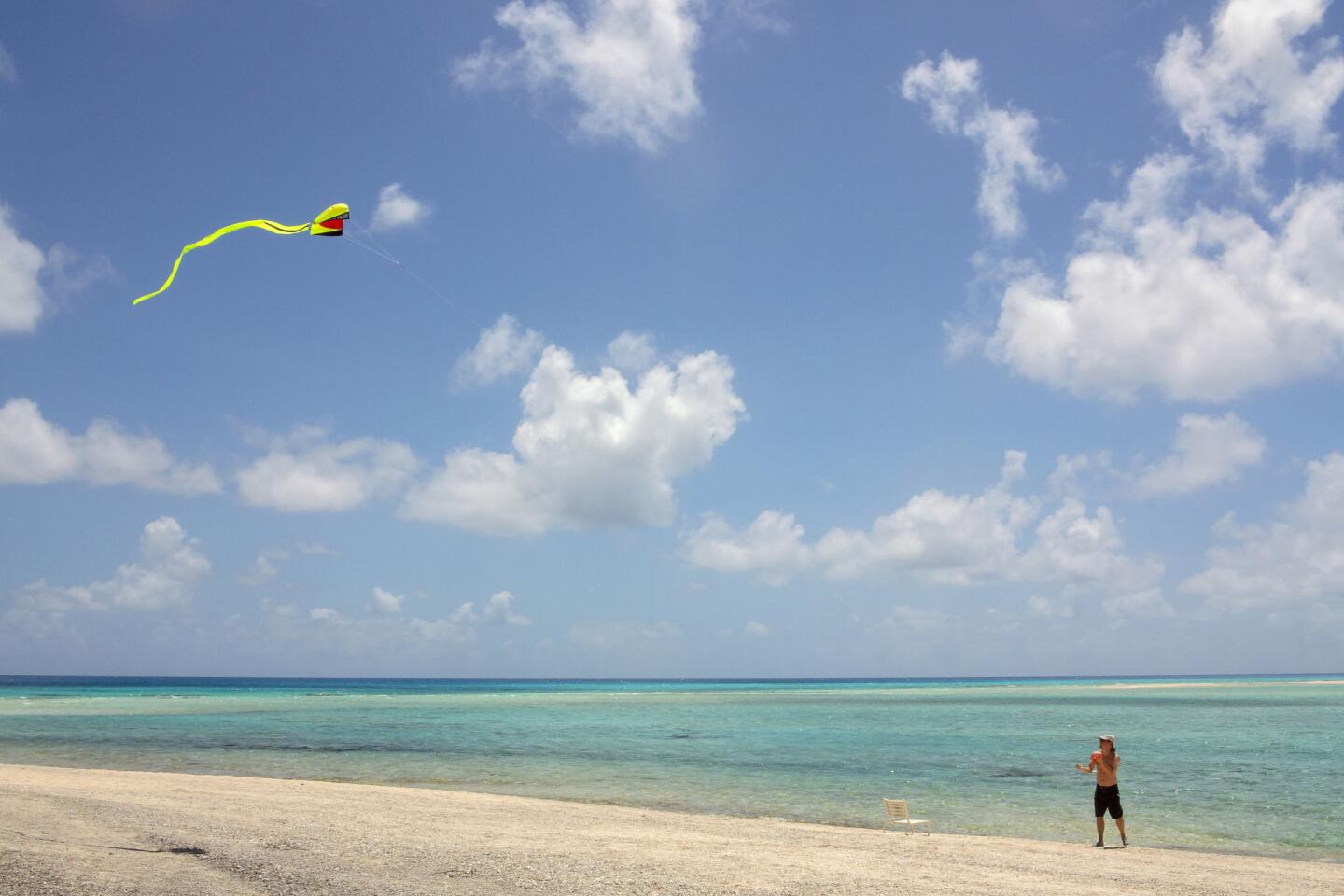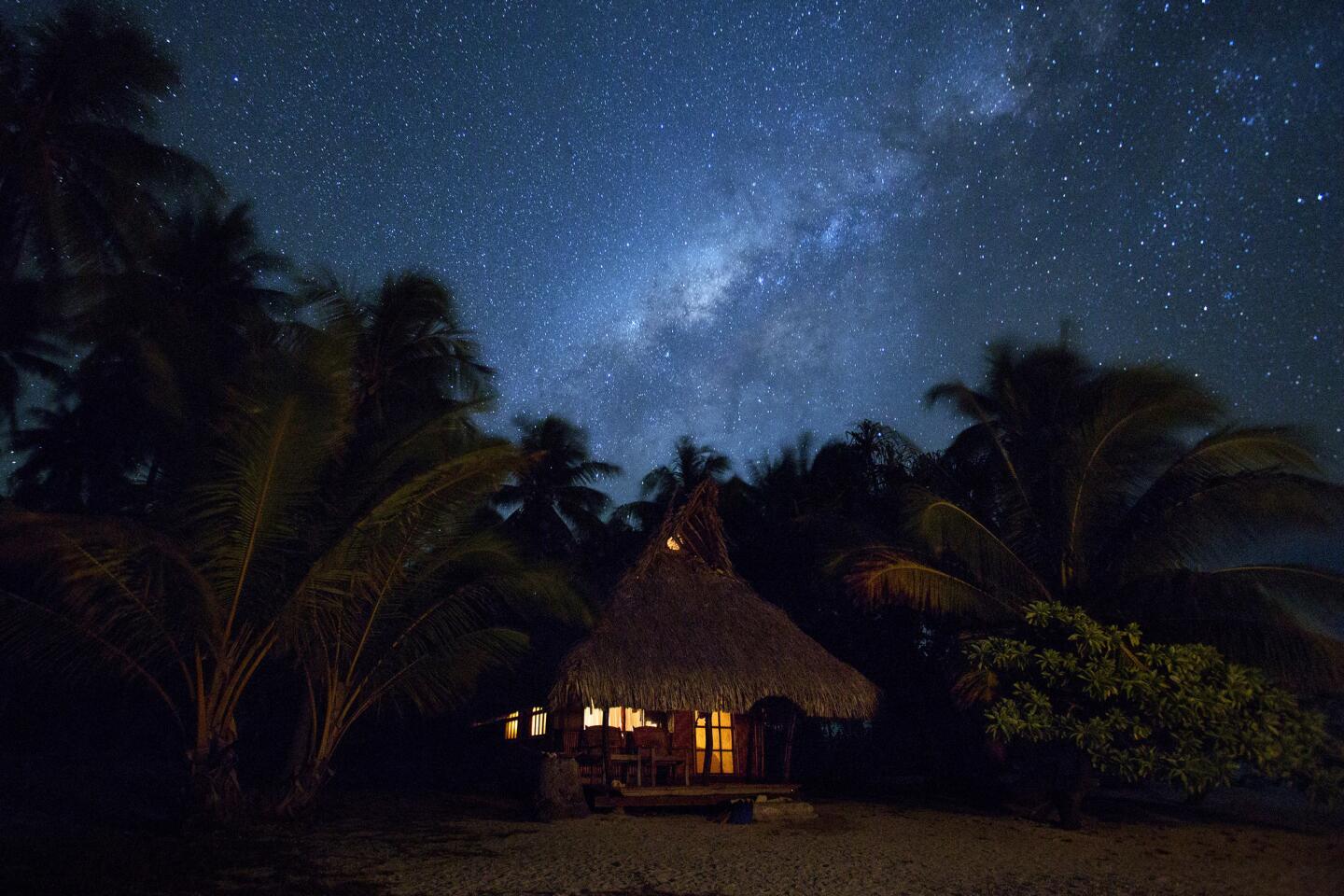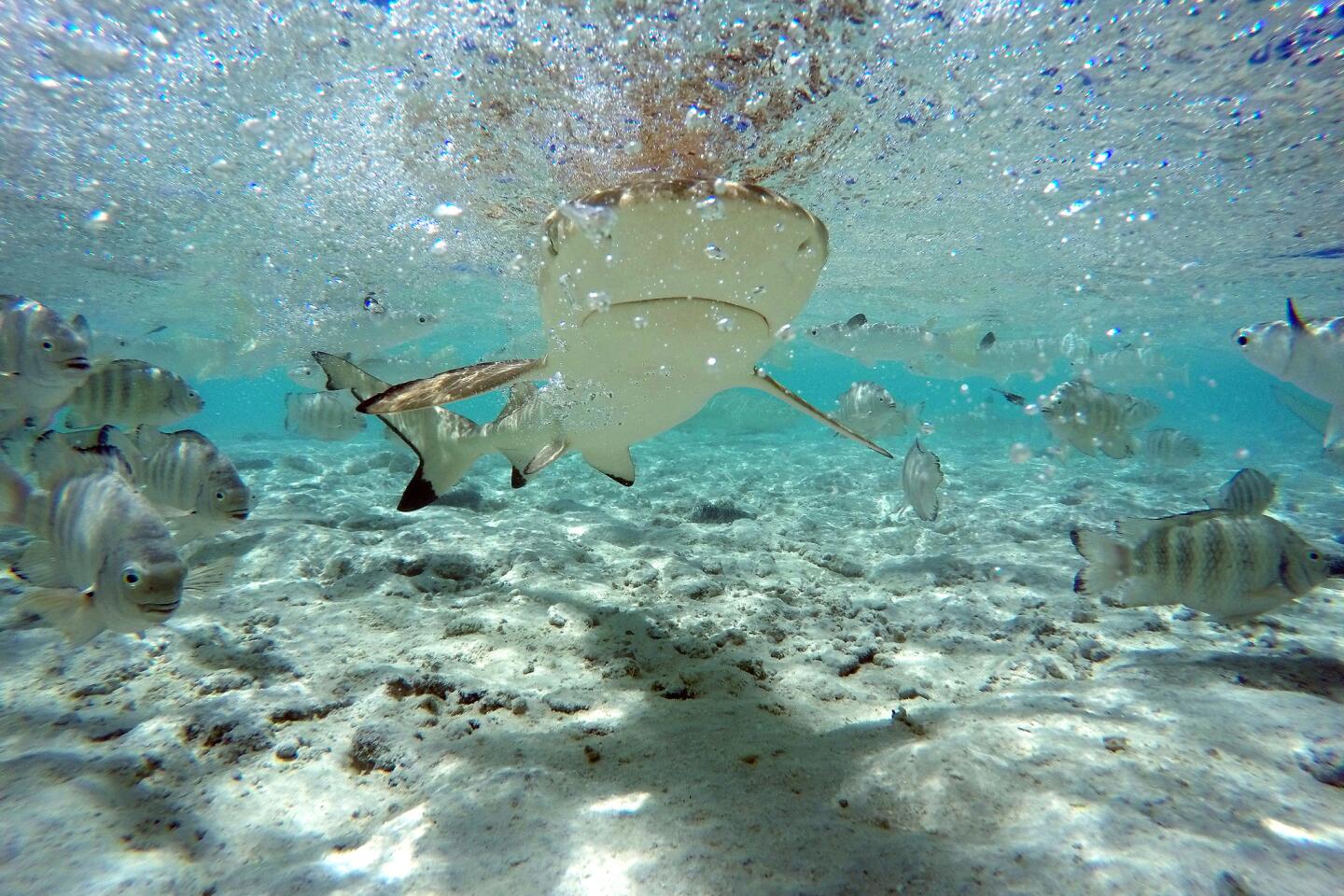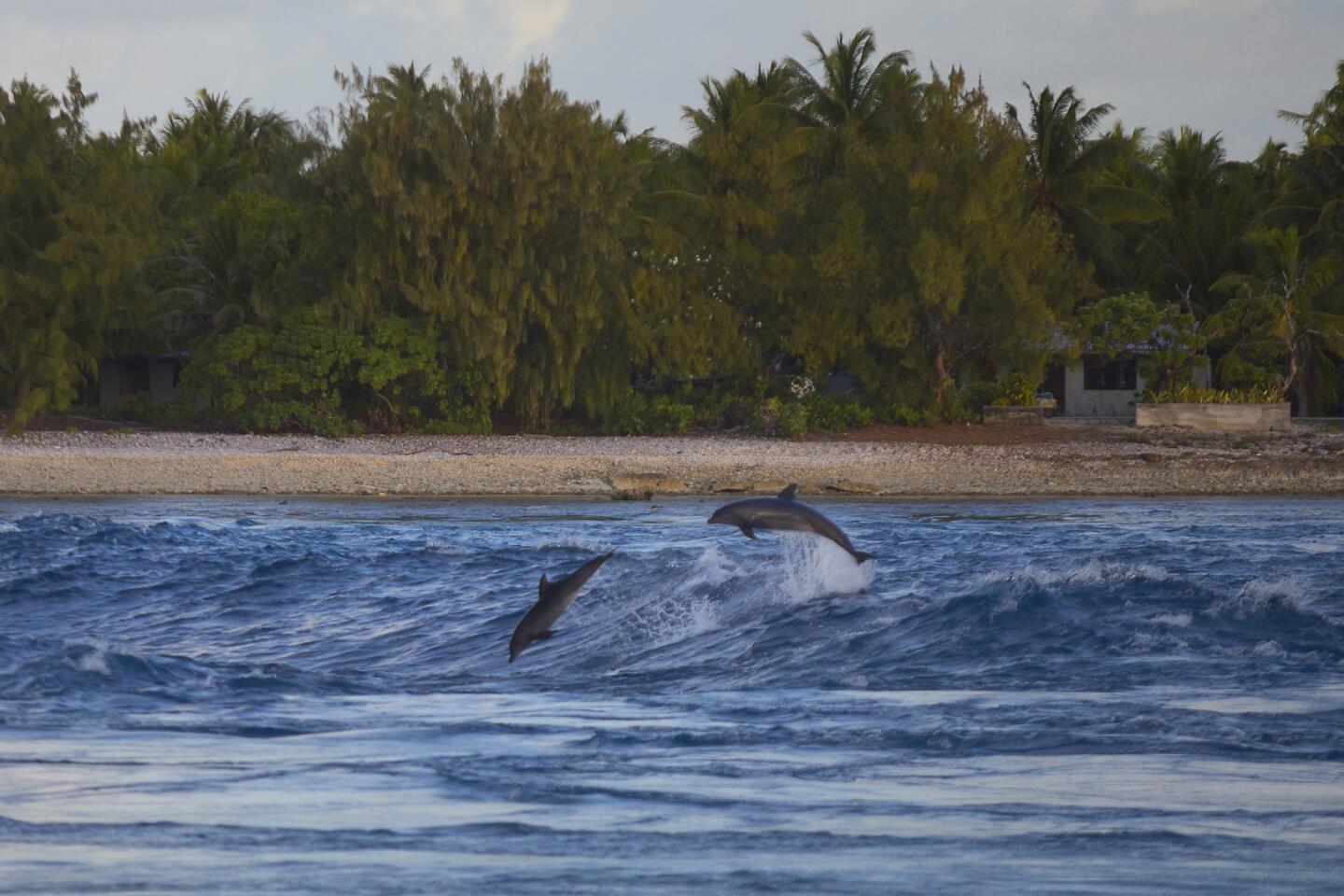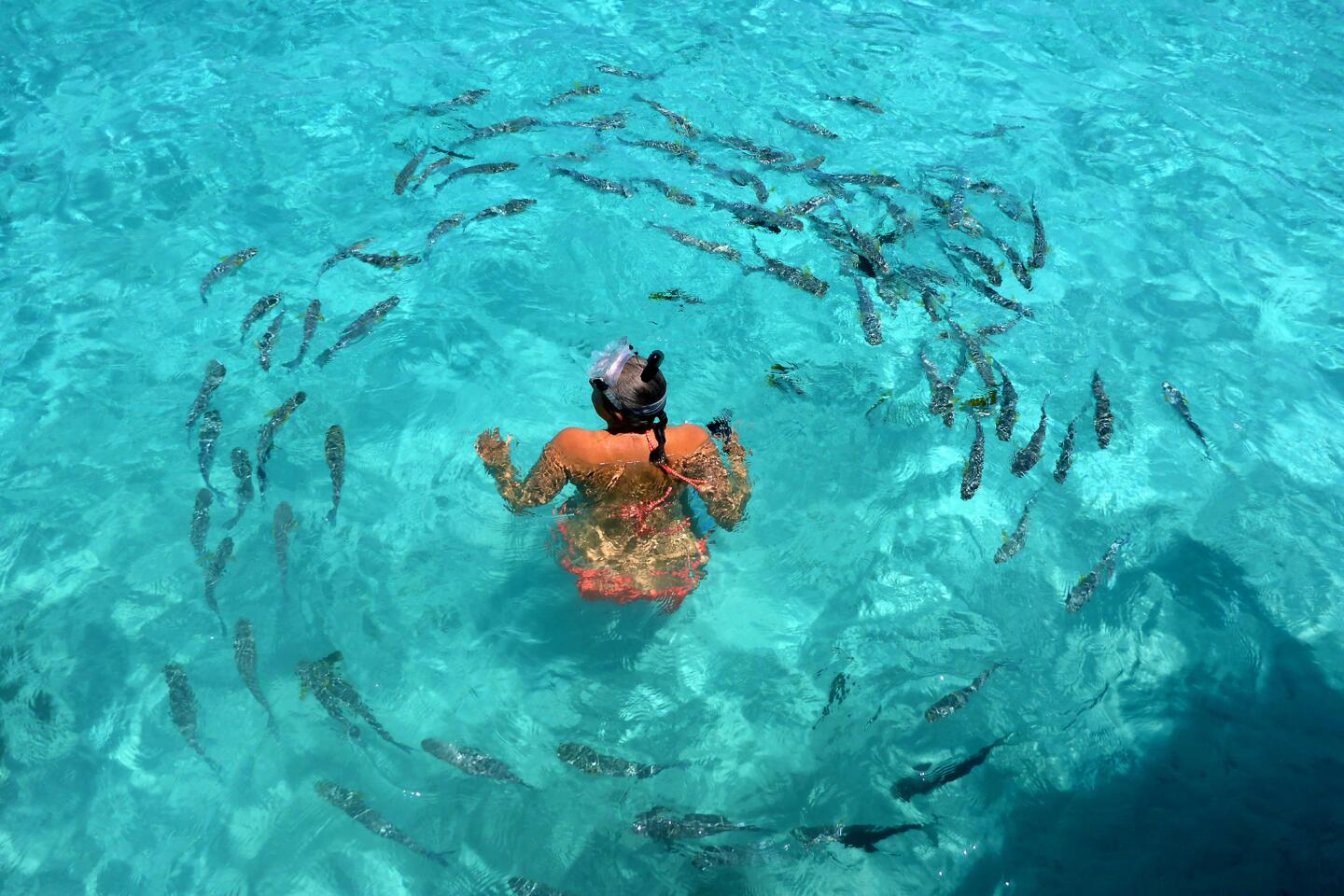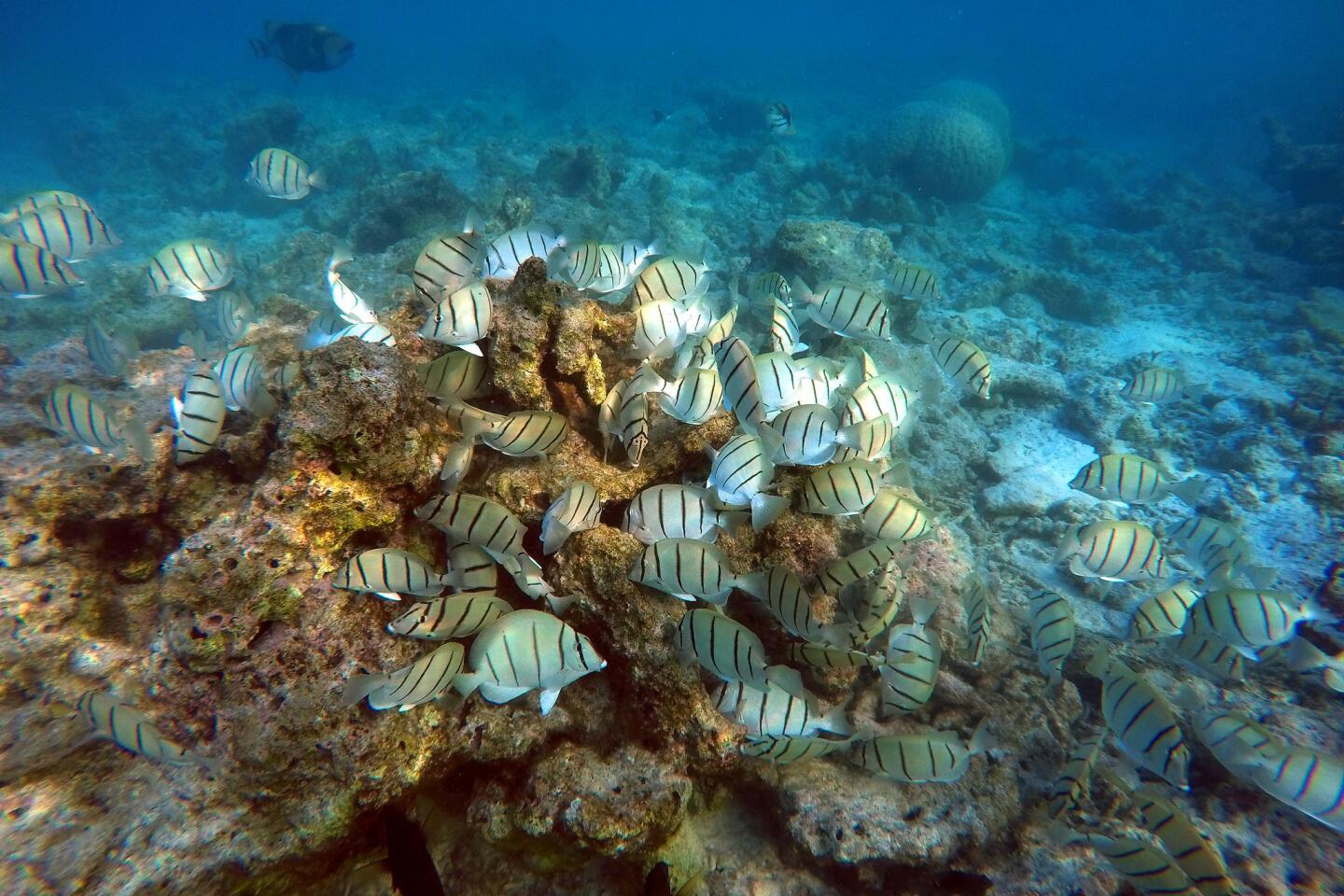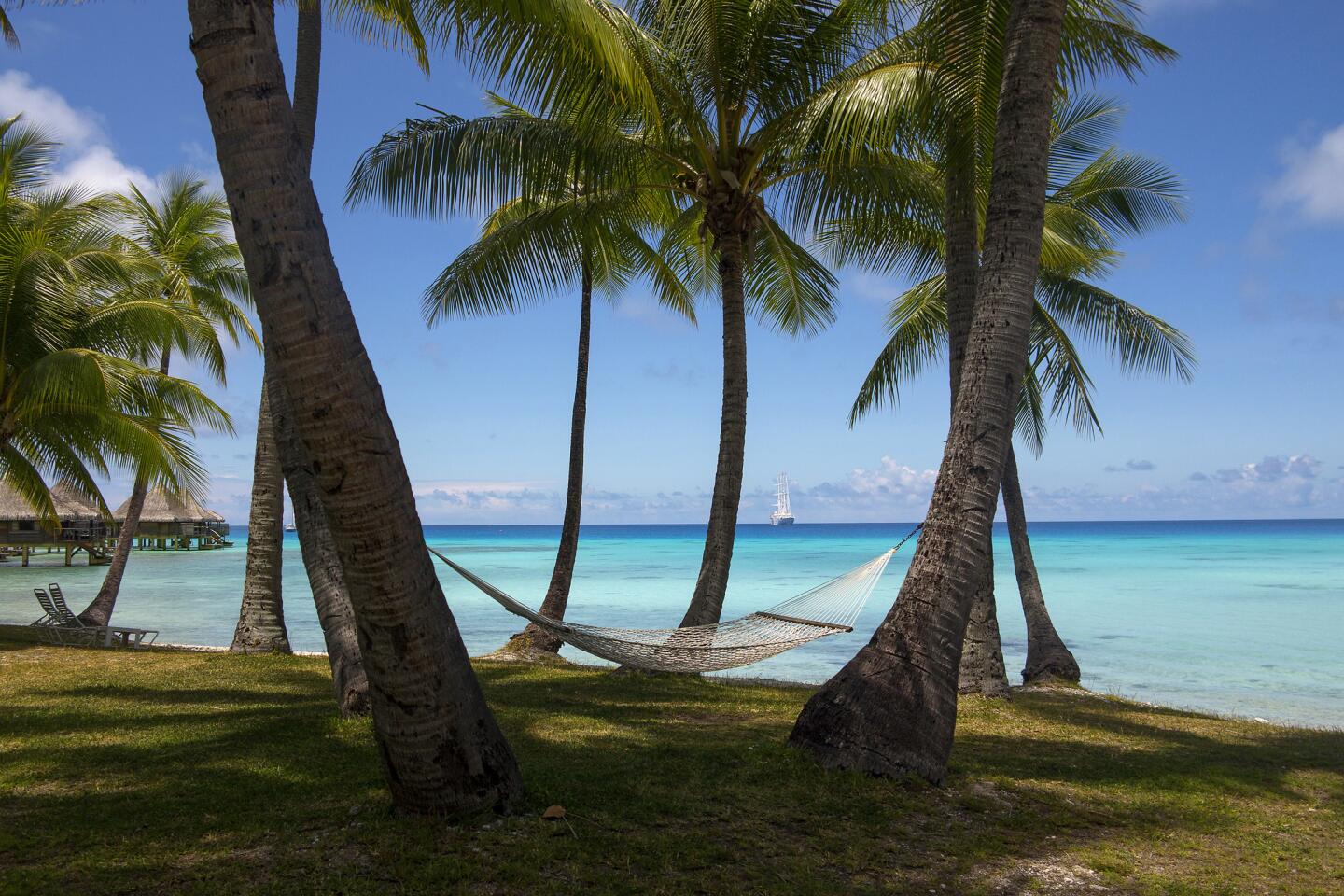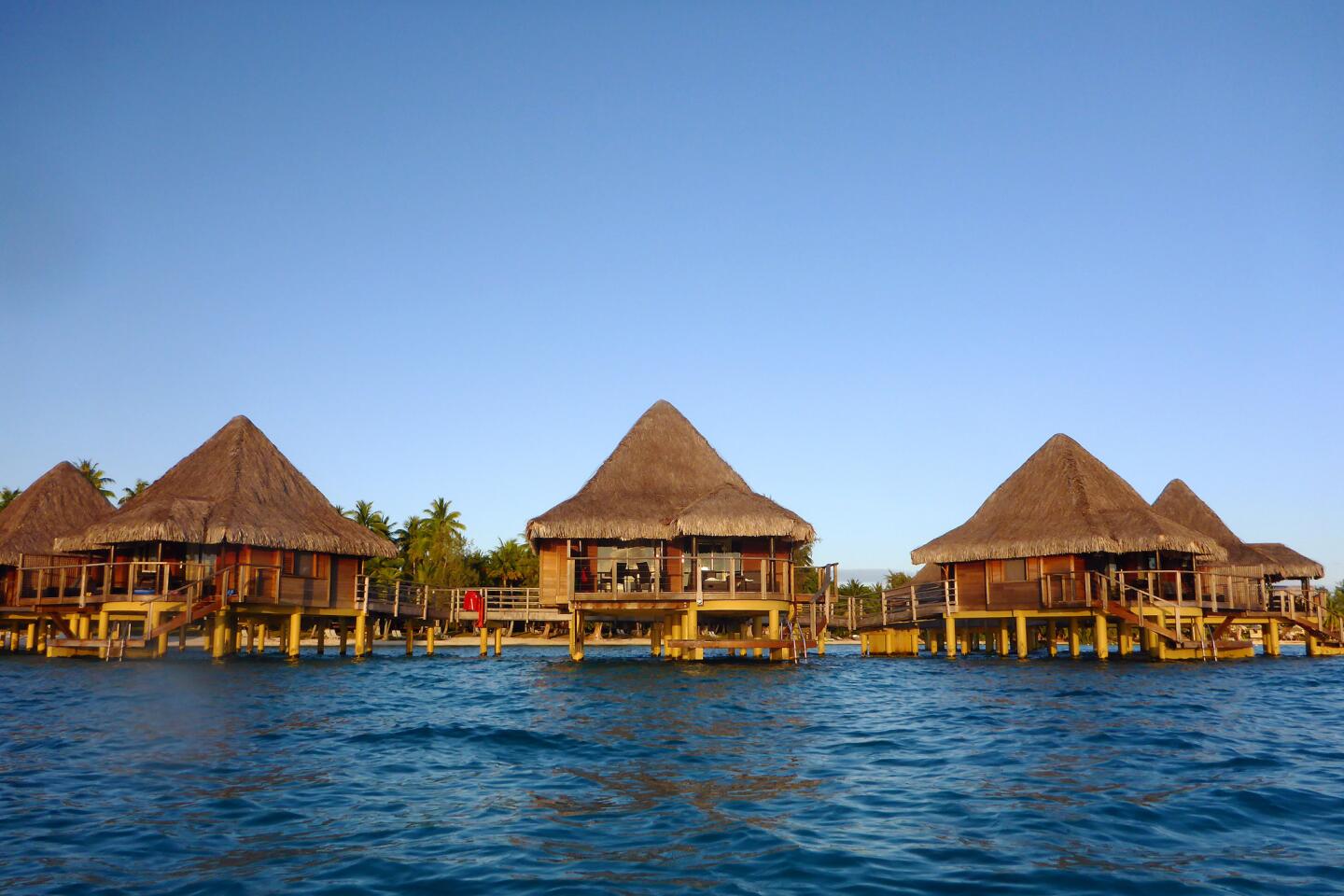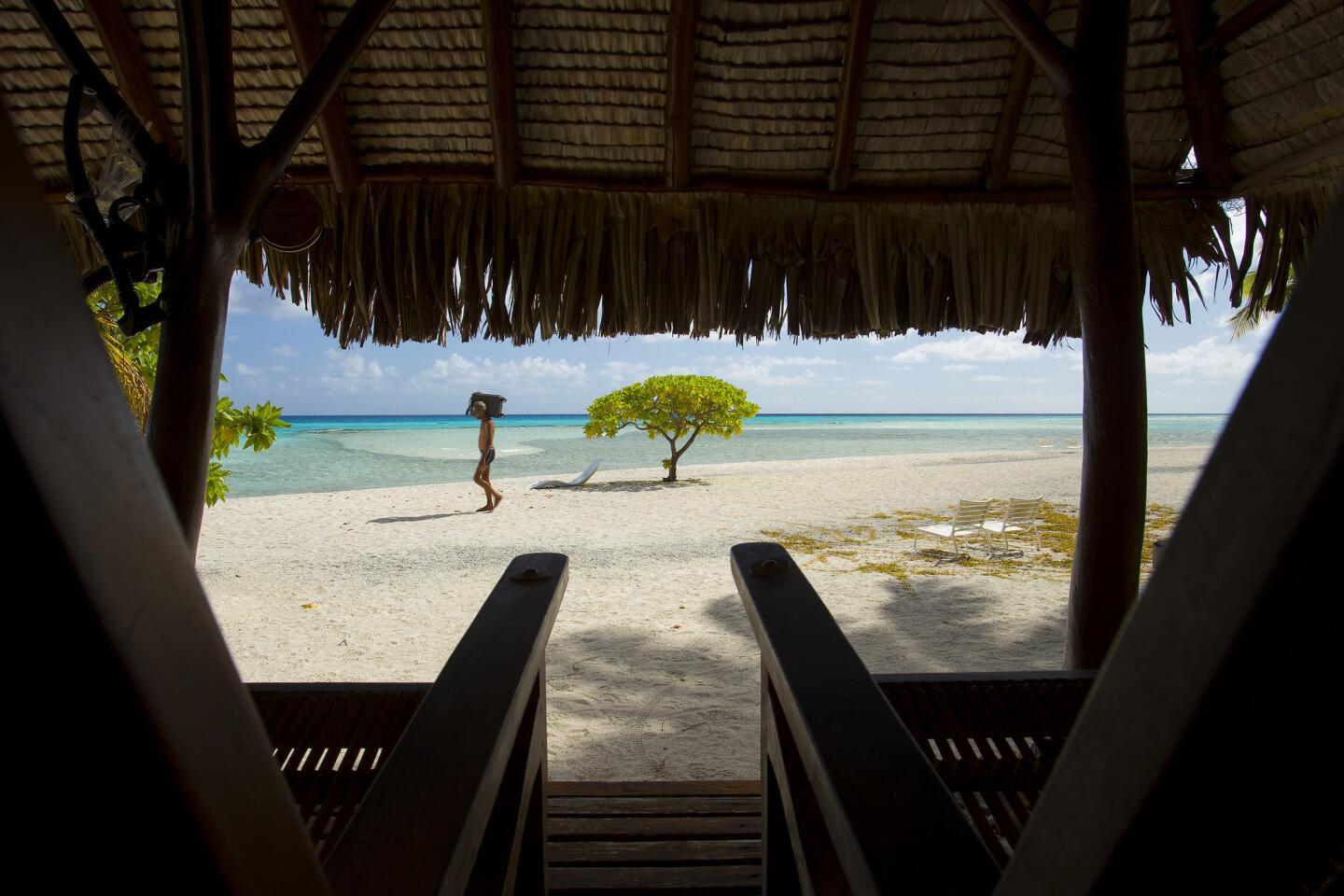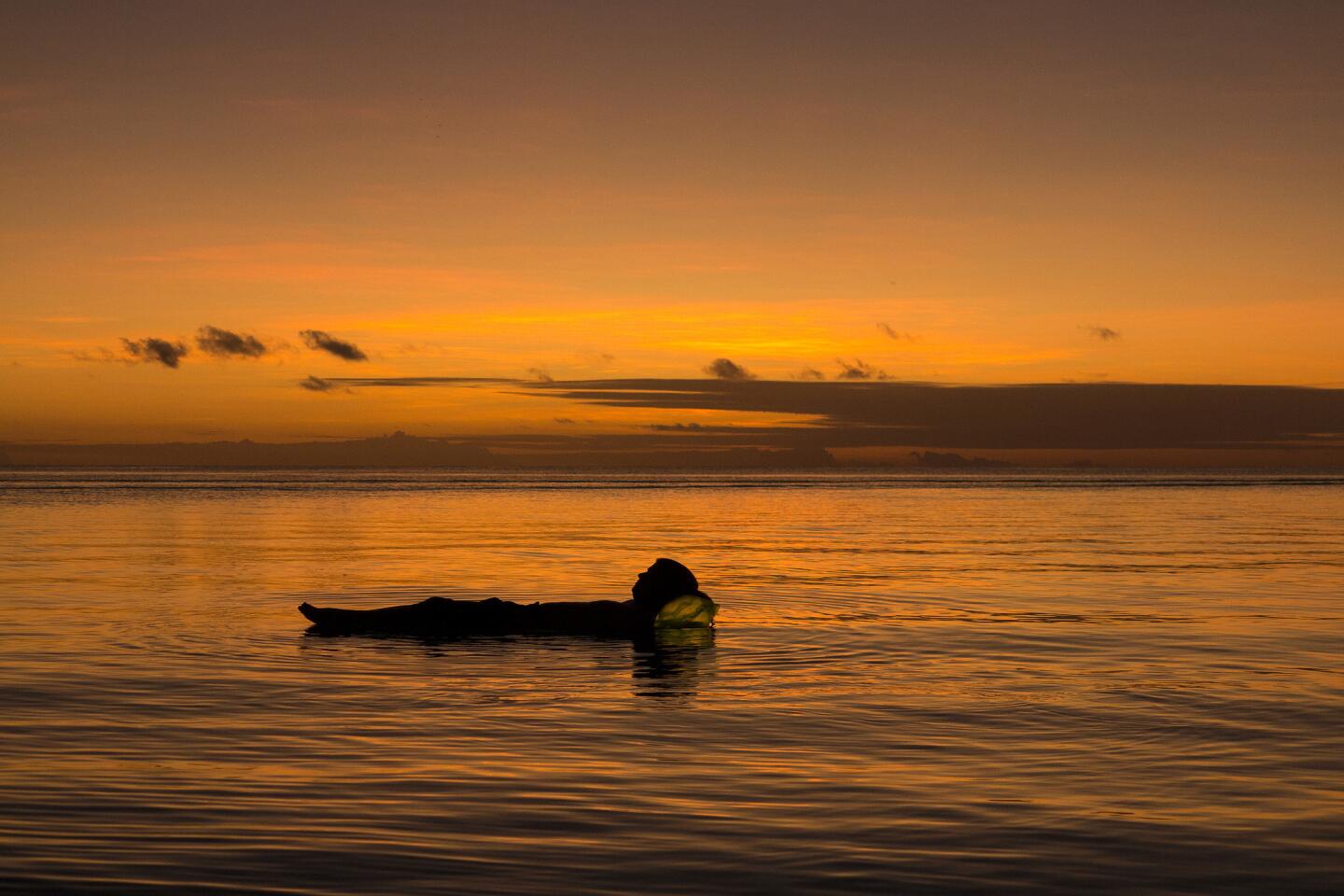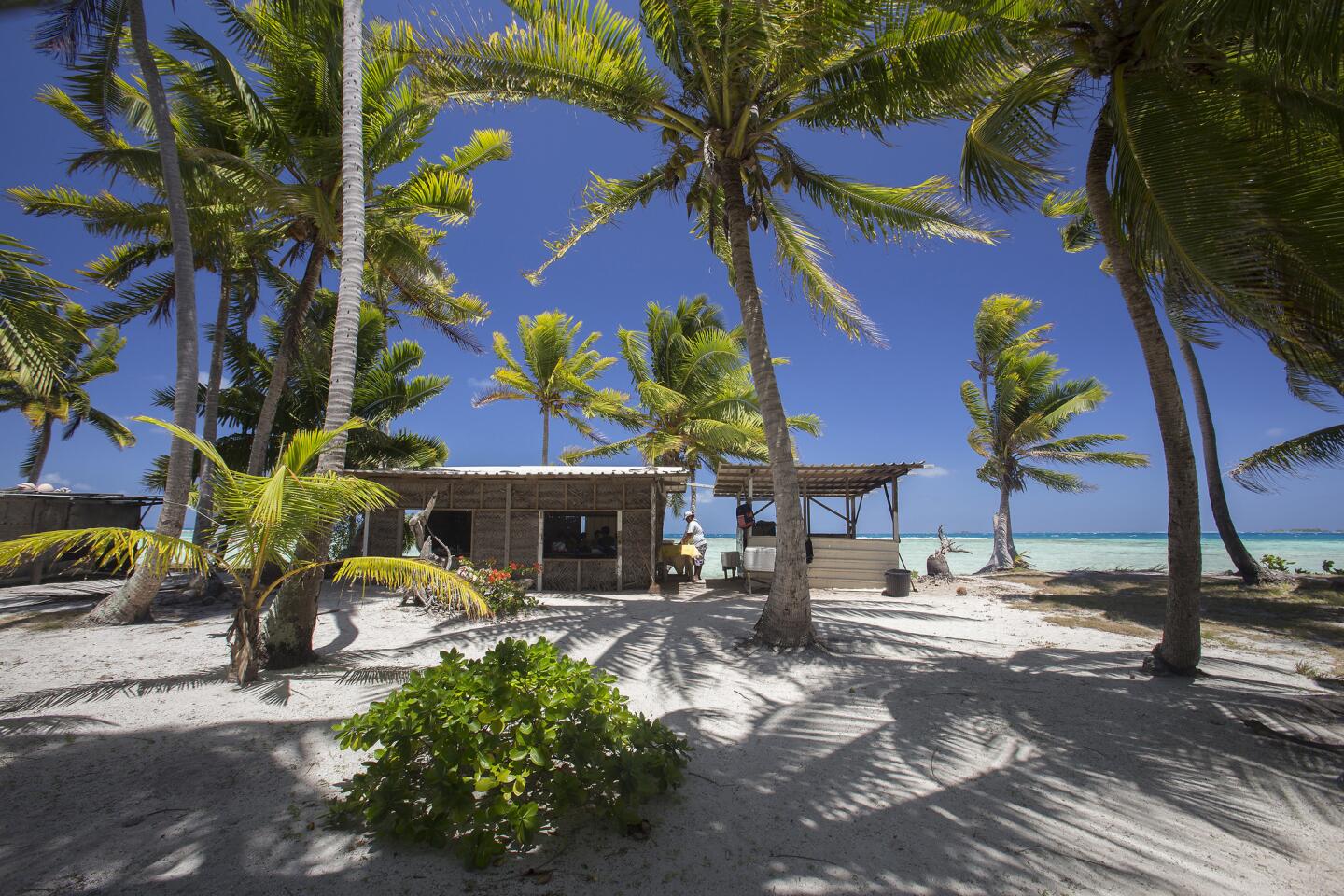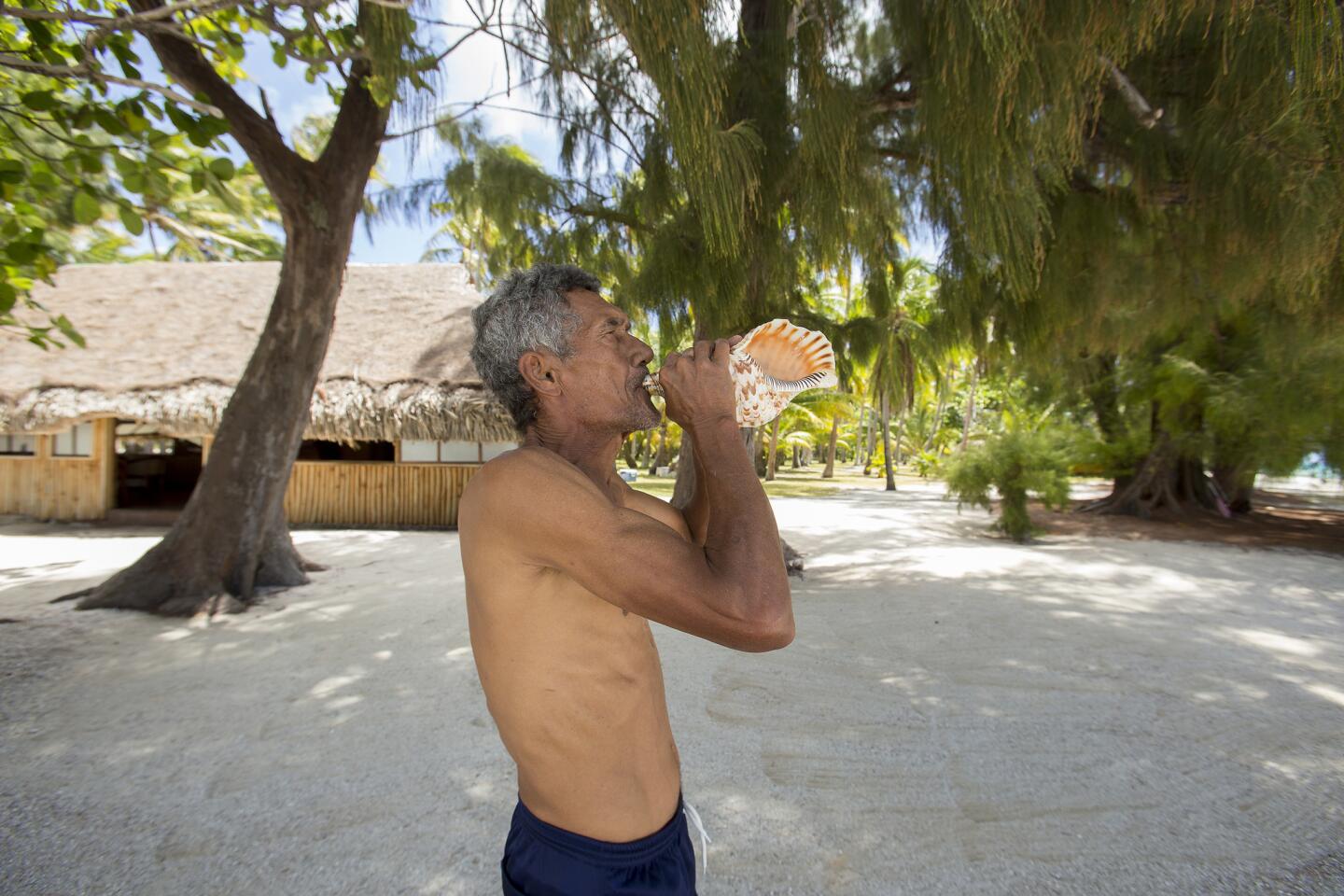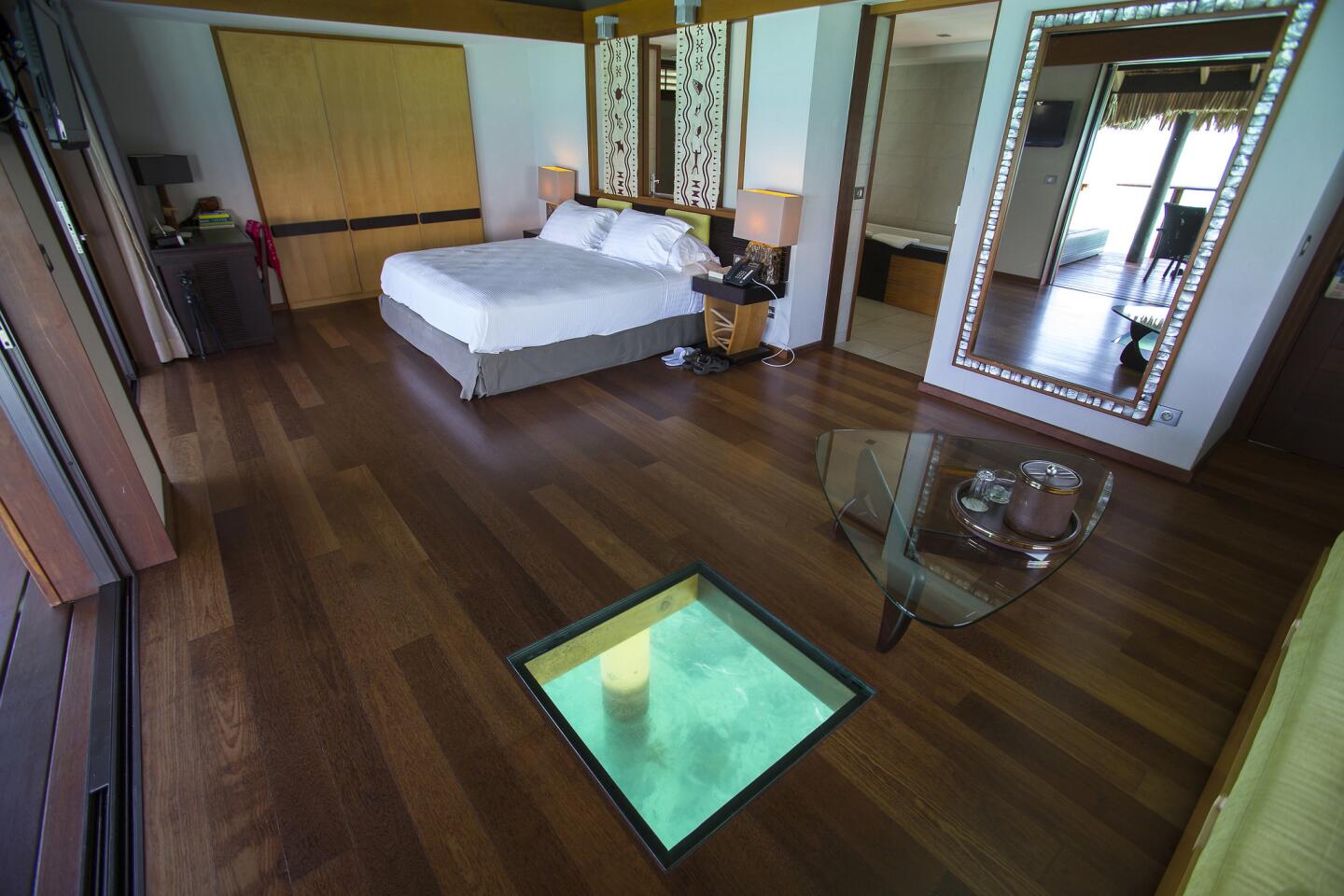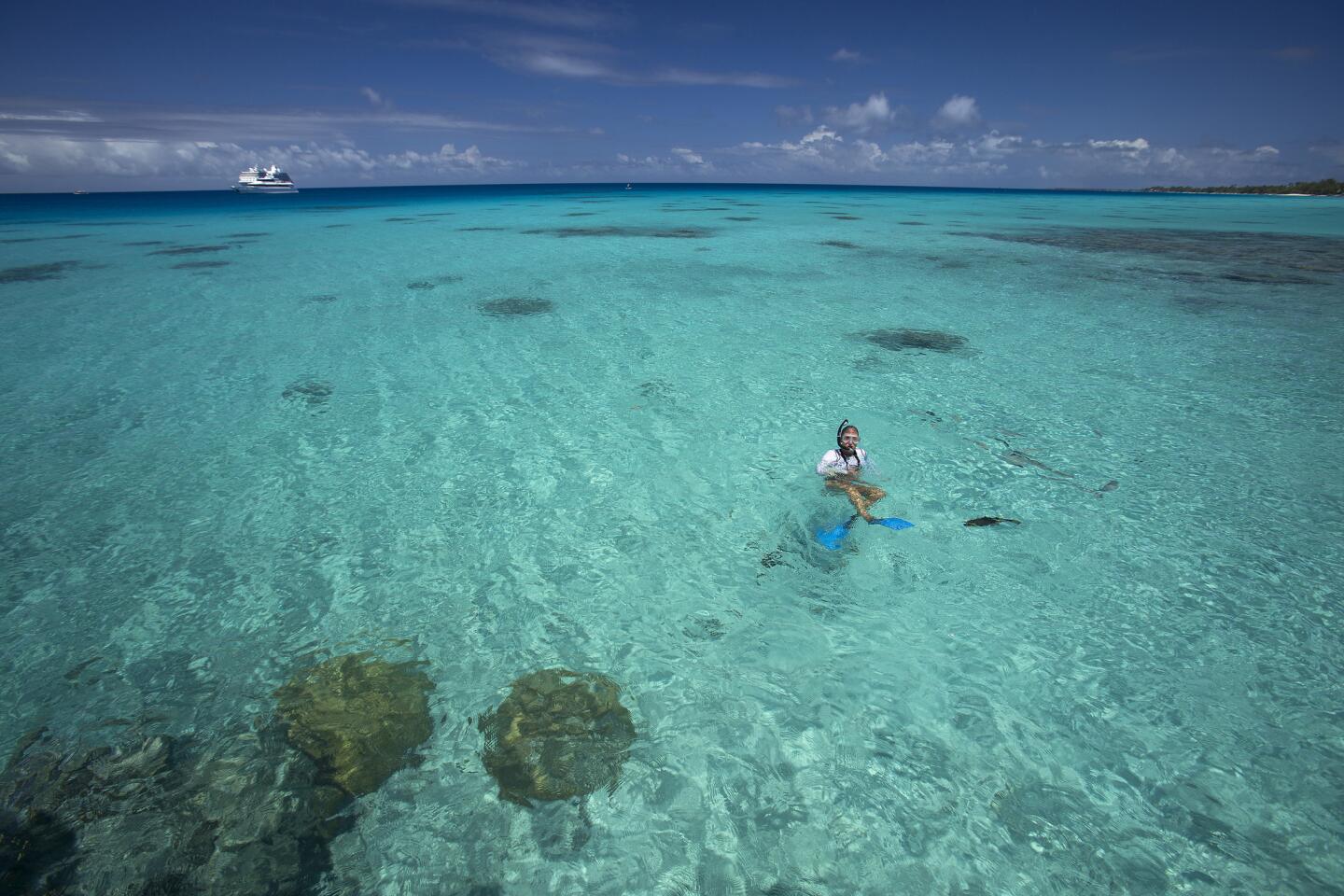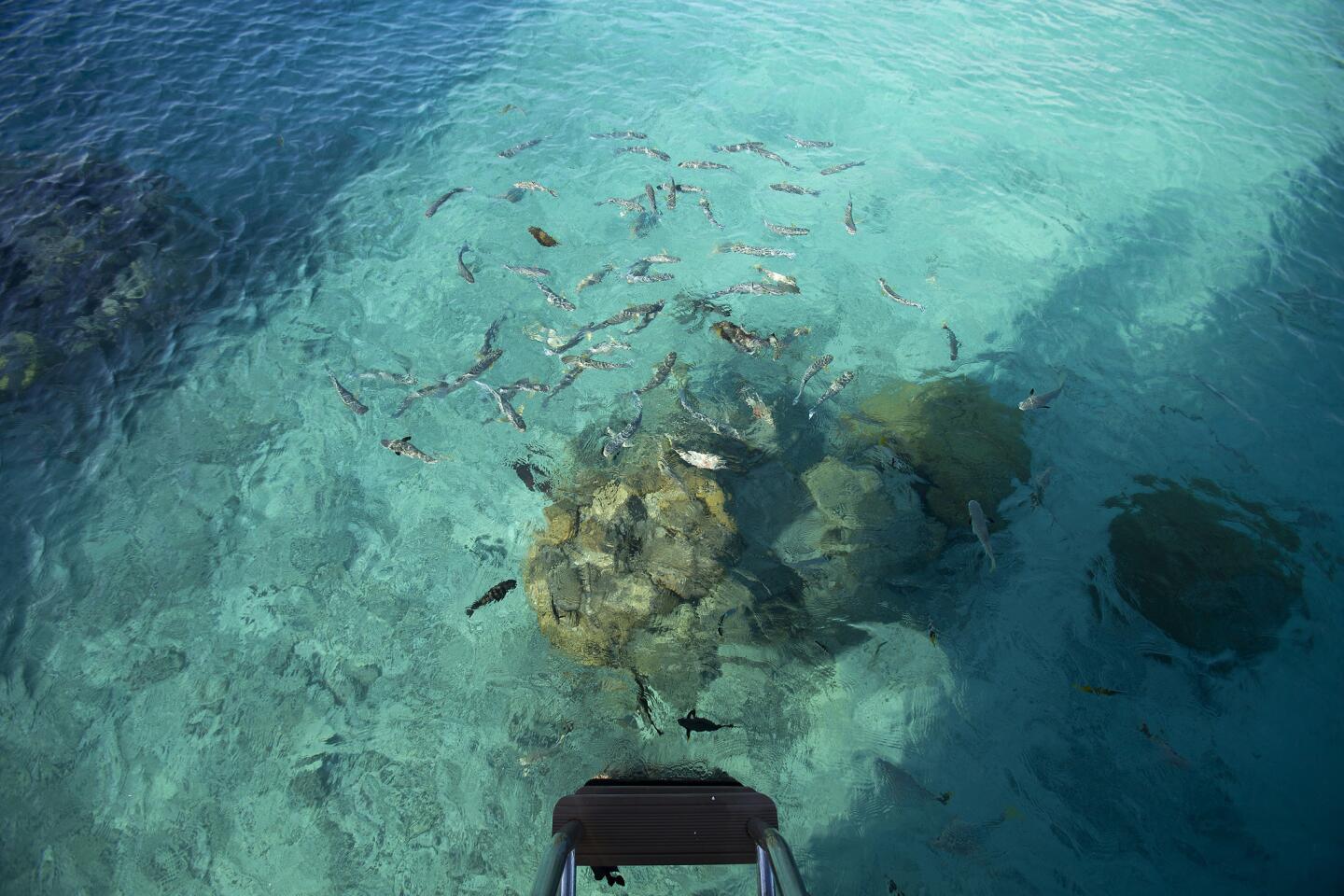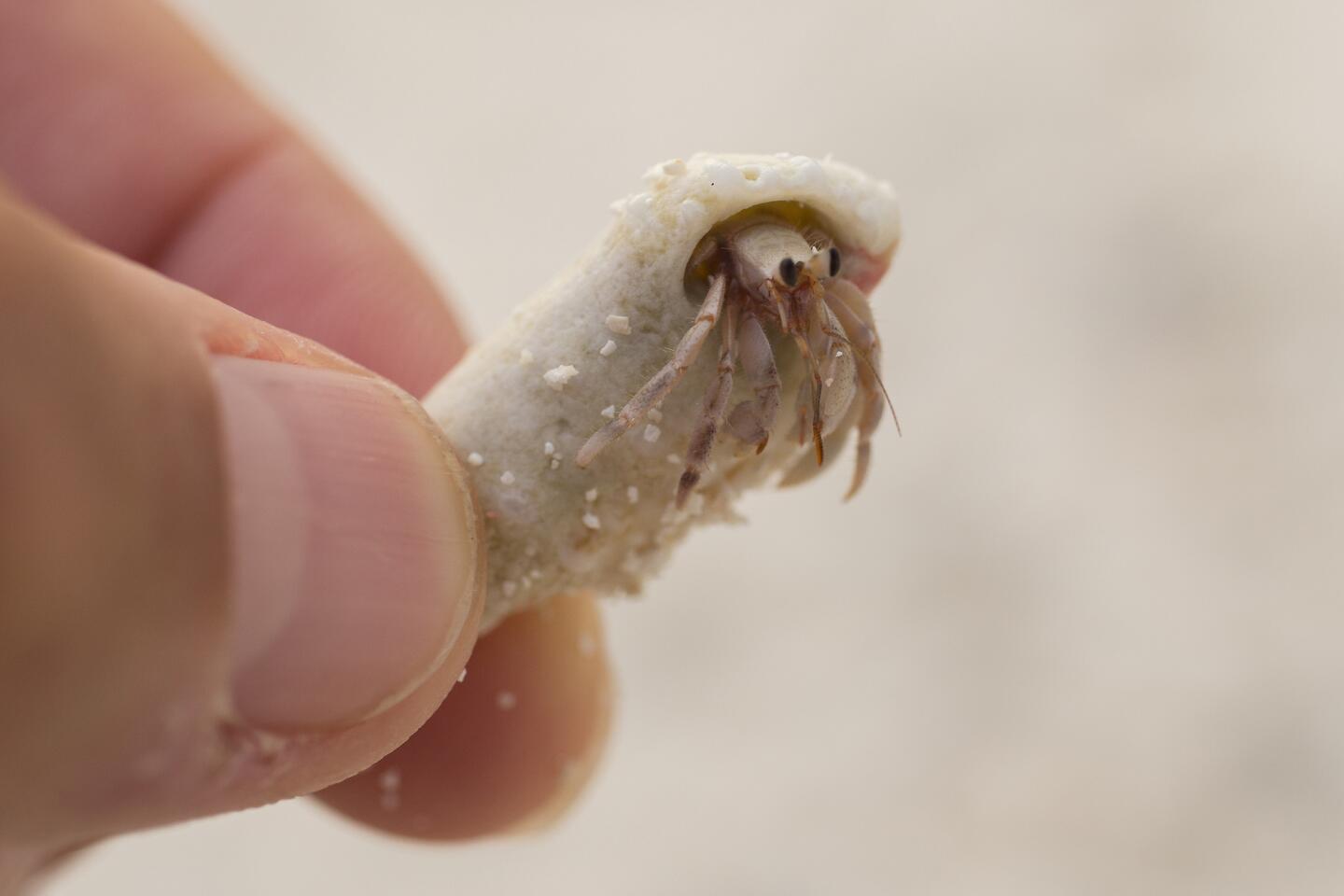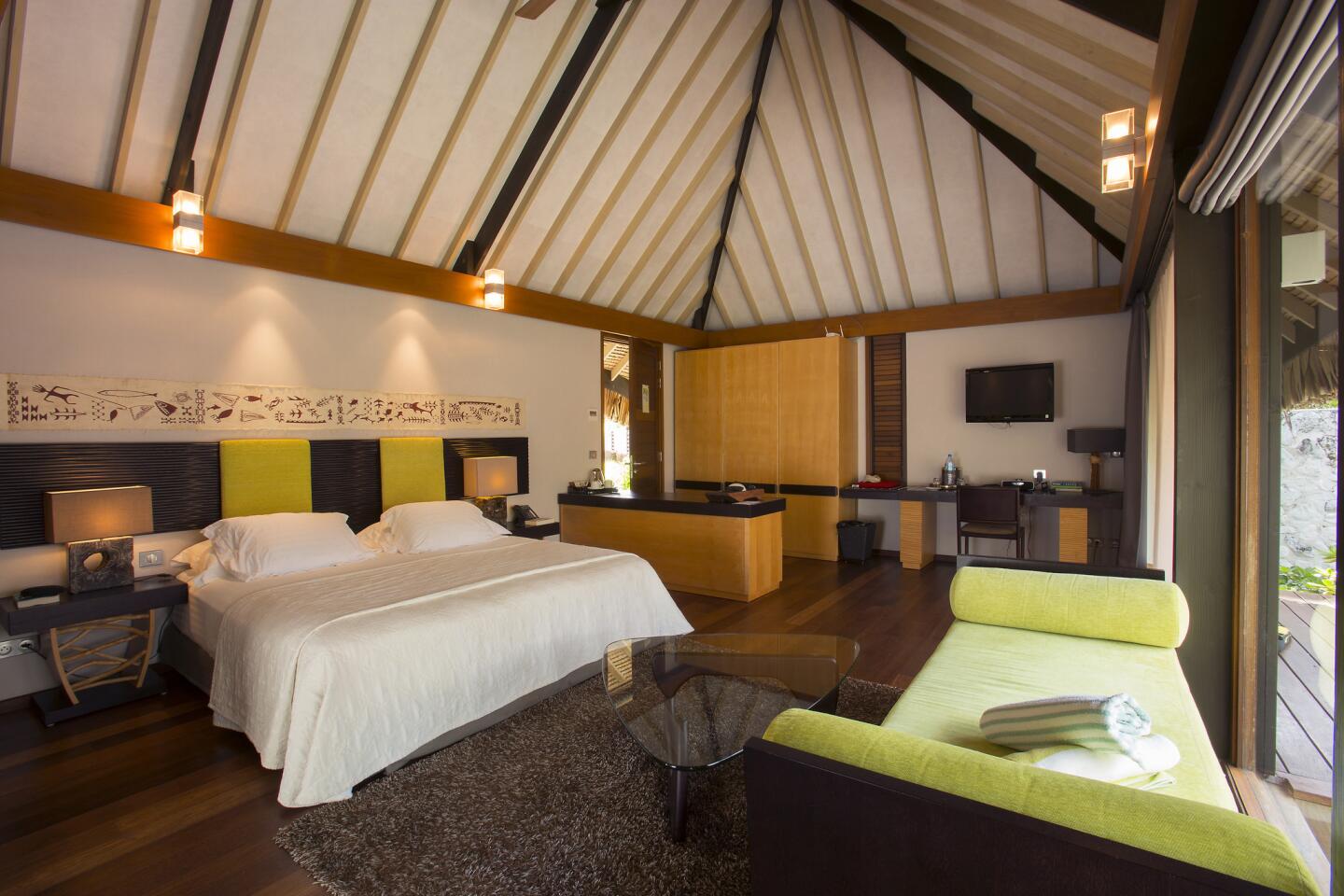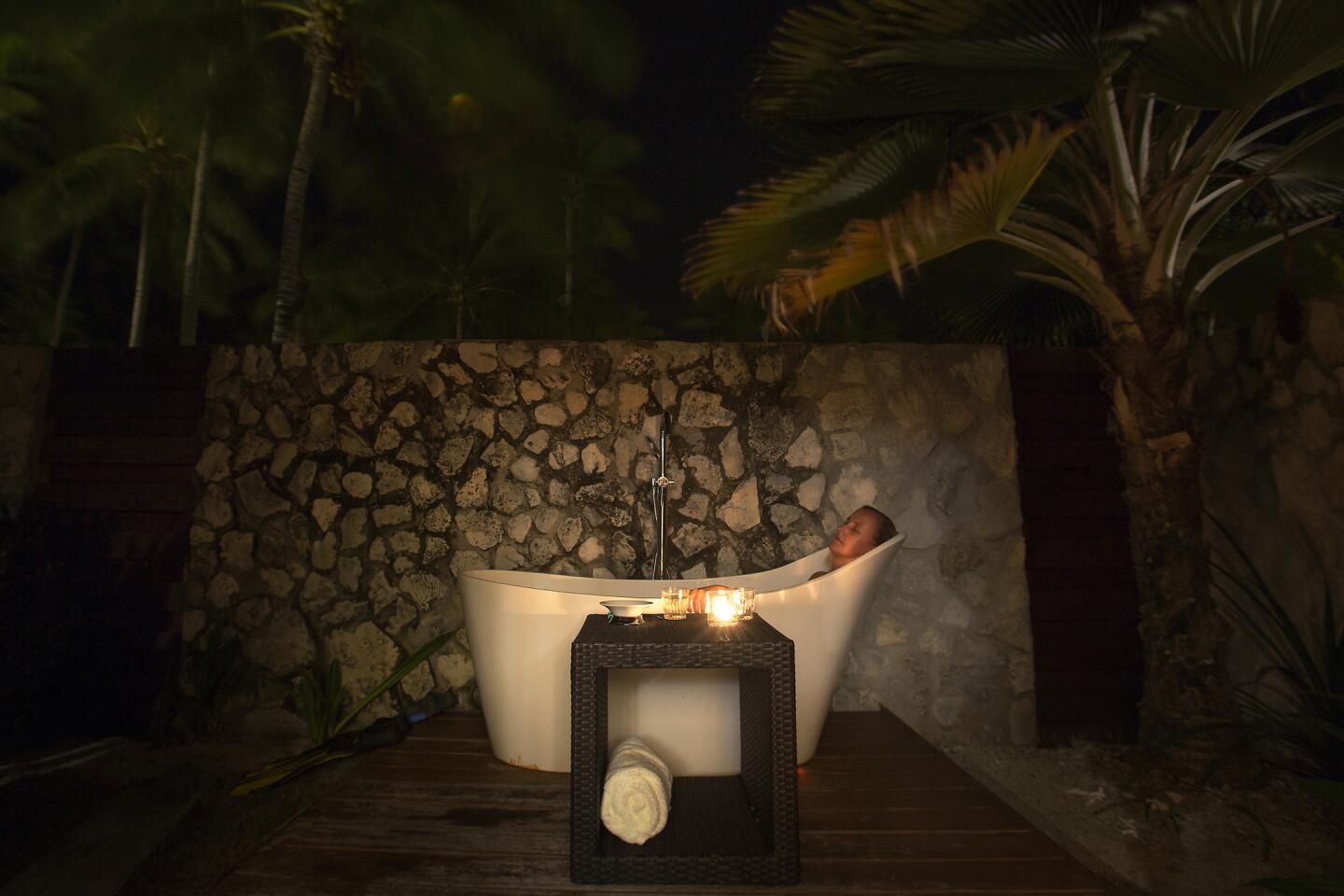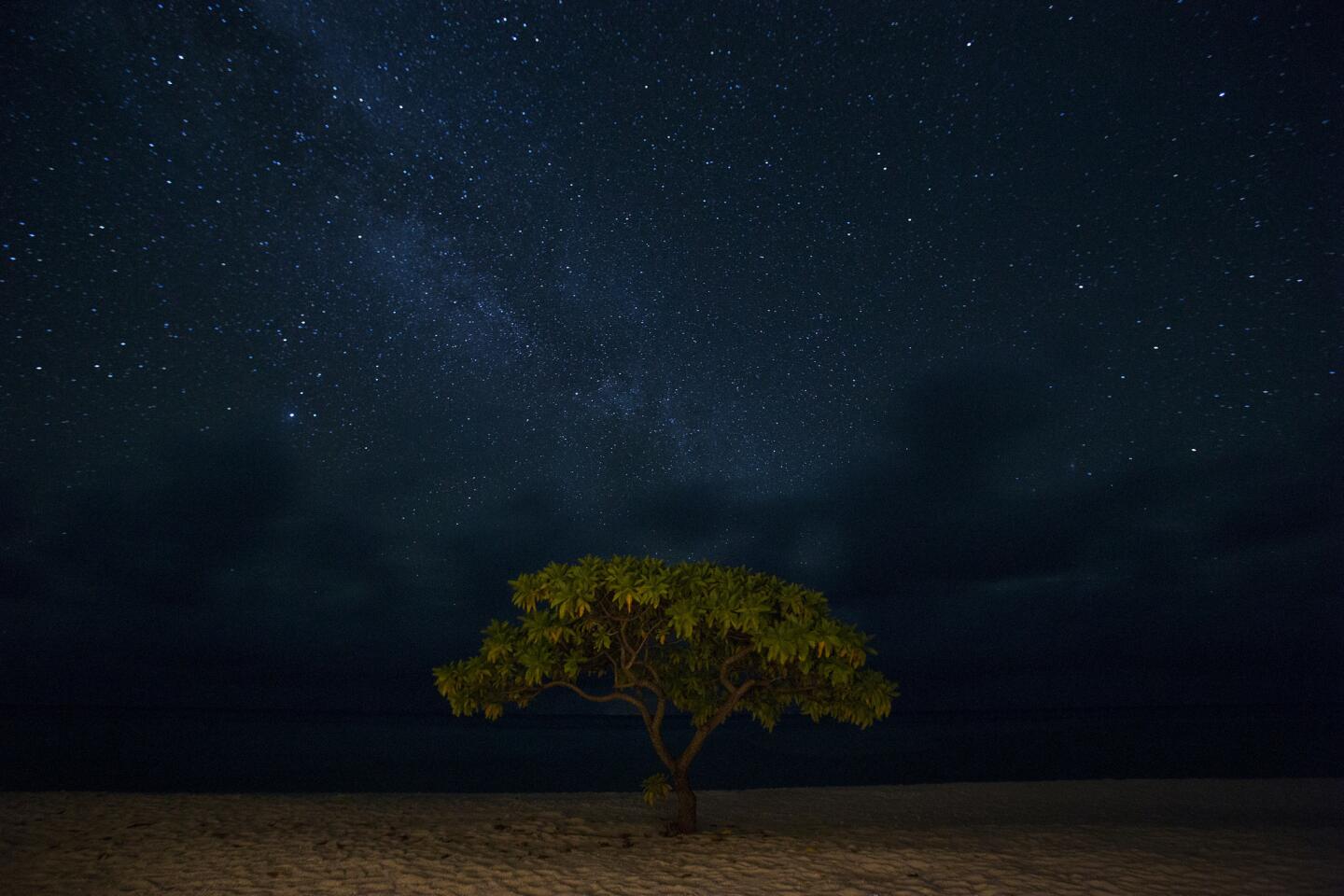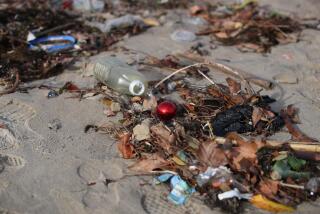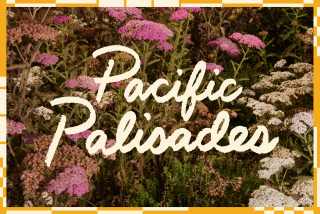Unplugged in Rangiroa, French Polynesia: no phones, no tablets, no computers ... just nature
“Hey, I just realized this doesn’t have auto-correct,” my husband, Jeff, said as he was scribbling on the first page of the journal we just had purchased at Los Angeles International Airport. Our new life without smartphones, tablets and computers was going to take some getting used to.
The decision to forgo connectivity on our second trip to the South Pacific hadn’t come easily because our phones are our constant companions. But after recently spending a few hours gardening — phone-free — I realized how much I had enjoyed that little break, and I wanted more.
I proposed an unplugged vacation to Jeff. At first, we weren’t sure we could do it. He had doubts; I had anxiety. Dozens of what-ifs tumbled through my head.
But the desire to be free of the constant pull of calls, texts, emails and social media proved stronger. We wanted a real getaway.
We were headed to the beautiful atoll of Rangiroa in the Tuamotu Archipelago of French Polynesia, a one-hour flight northeast of Tahiti. Two years ago, we had honeymooned on nearby Bora-Bora and loved it so much we wanted to come back to see more of the islands.
The Tuamotus form the largest chain of atolls in the world, and because the islands sit low in the water, it was easy to get that end-of-the-world feeling we wanted. Rangiroa had been a contender for our honeymoon, so it was at the top of our list for this 12-day visit in October.
We decided to stay at Hotel Kia Ora Resort & Spa, located on the northwest part of the atoll, between the Avatoru and Tiputa passes. It was renovated in 2011 and offers a range of bungalows full of creature comforts. We had trouble choosing just one, so we decided to start our vacation in a garden villa with a private plunge pool and finish in one of the over-water bungalows that are typical in French Polynesia.
We expected the highlight of our unplugged vacation to be the three nights we planned at Kia Ora’s secluded satellite property: the Kia Ora Sauvage, five bungalows without electricity on a remote motu, or islet, on the south side of Rangiroa. What better place to leave behind the world of electronics and just be together, enjoy life and all that nature has to offer?
Without electricity or cell towers, we’d have little use for our devices at Le Sauvage. But we needed a plan for the rest of the trip. Simply turning everything off wasn’t going to work. If we had our devices, we would use them. We had to go a step further and leave them at home. After a solemn turning-off ceremony, we tucked them away the morning of our departure.
It was the right decision, and much easier than I thought. Soon, we began to see the benefits of unplugged travel. Imagine going through airport security without having to pull anything out of your carry-on or pockets. Just take off your shoes and you’re done. No chargers, cables and endless accessories to pack, no frustration about spotty Wi-Fi.
But the best part came when we were on Rangiroa. At home, my phone charges on my nightstand, and it’s usually the first thing I reach for in the morning. It easily eats up half an hour of my time even before I start my day.
Without screens, there is just nature. Without electronic distractions, all we had to do when we woke up was kick back the covers and fulfill the promise of the day ahead.
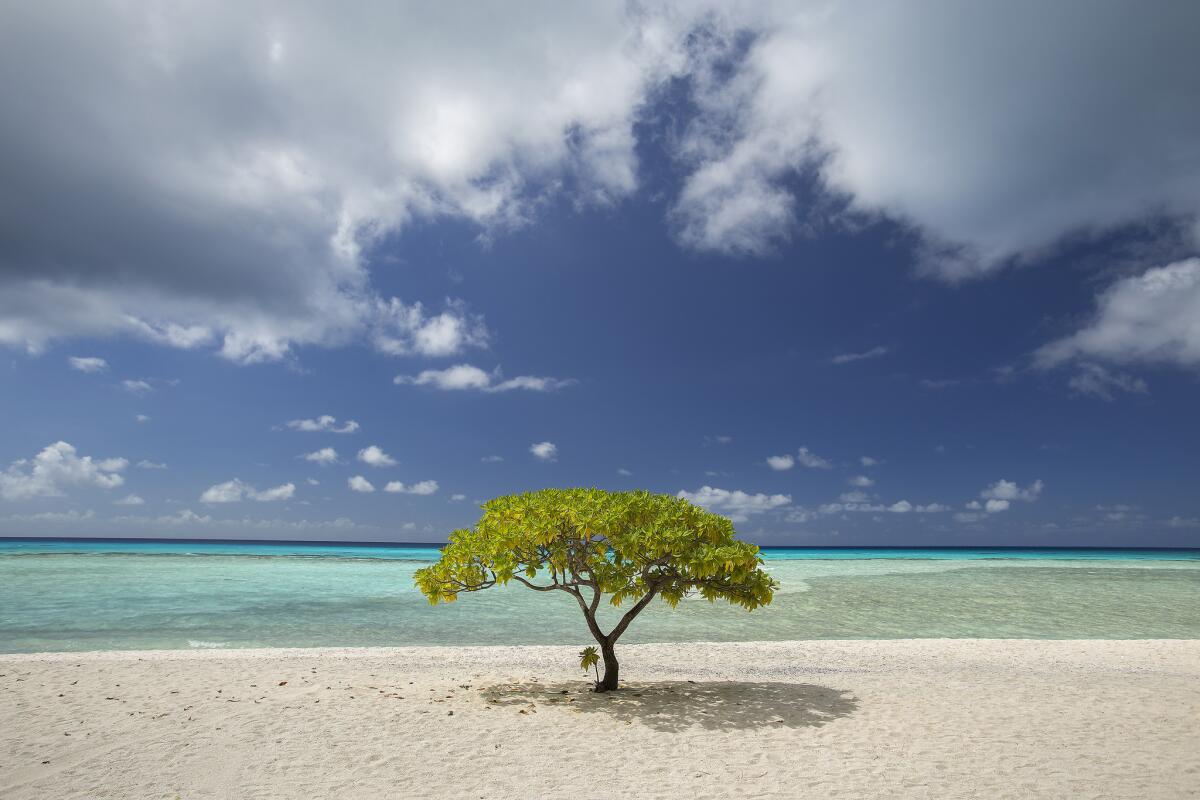
A lone tree stands on the beach of Motu Avea Rahi. Hotel Kia Ora’s private island is also known as Le Sauvage.
The simple life on the private island of Motu Avea Rahi
One of the most refreshing things about unplugged travel is breaking away from your usual pastimes and replacing them with different ones. I felt almost like a kid again as I packed my travel editions of Battleship and Connect 4, and a kite, something I hadn’t used since my dad made one for me when I was little.
We wanted to rediscover a more simple life, and we thought we’d find it at Hotel Kia Ora’s private island, Motu Avea Rahi, also known as Le Sauvage, one hour by boat from the main resort.
There are only five bungalows here, with a maximum of 10 guests cared for by two hosts, Michel and his wife, Tetuanui. The island is small; we walked around it in less than 15 minutes after we arrived. The restaurant and kitchen have electricity but the bungalows do not, although each had a water heater.
Each thatch-roofed bungalow is made from local materials, and all are situated on the palm-fringed beach with impressive lagoon views. They have king beds with the same heavenly bedding that we found at the main hotel — fluffy pillows, crisp white sheets, a waffle-weave cotton blanket and a mattress so comfortable we wanted to stuff it in our suitcase and take it home.
In the back of the bungalow, separated by a driftwood curtain, is a cute bathroom with a giant shell for a sink and a floor made up of coral pieces. Every afternoon at 5, Michel would deliver an oil lamp to each bungalow.
On our first two nights, two other couples — Cécile and Michel from France and Brigitte and Stephan from Germany — also were here. Meals were served family-style, so we got to know one another and had a few chuckles trying to communicate in three languages. Breakfast was my favorite meal of the day, with pancakes, French toast and yogurt, while lunch and dinner usually included freshly caught fish, fruit and a vegetable platter.
We were the only guests on our final night, alone on a tiny speck of land in the middle of the South Pacific. There was no moon while we were there, but the stars were so bright we could easily see.
We read books, flew our kite, snorkeled around the unspoiled coral and spent quality time soaking up our beautiful surroundings and recharging our inner selves. We found peace, calm and relaxation.
And those smartphones? Never missed them.

The sun sets behind Hotel Kia Ora’s overwater bungalows. Each of these rooms has a deck with direct lagoon access for snorkeling.
The dolphins, sharks and sunsets put on a show
Even though there is no nightlife or much shopping on remote Rangiroa, we found plenty of things to do.
On our first night, we took a 15-minute walk from our hotel to a point on the Tiputa Pass known as Cité des Dauphins.
Twice a day when the current is strong, you can see bottlenose dolphins here, jumping and frolicking in the waves. Some dolphins leaped so high and so gracefully that people cheered.
Also on our wish list was a visit to the Blue Lagoon, a natural pool on the edge of the main reef formed by a string of motu, sand banks and coral reefs. It offers the vistas that people expect when they imagine paradise, and its shallow turquoise waters are thick with small fish and blacktip reef sharks.
The experience was certainly worth the hour-long boat ride through choppy lagoon waters, although we were disappointed to see our guides feed the sharks and hoist one out of the water by its dorsal fin.
Rangiroa has two deep passes, or straits, that connect the lagoon at the atoll’s center to the ocean. Sea life congregates in these passes; stingrays and various species of sharks are mainstays, and it’s not uncommon to see manta rays. The current in the passes changes direction as the tide rises and falls, and drift snorkeling can be done safely when the current flows from the ocean into the lagoon. Snorkelers and fish are propelled through the water — sort of like flying underwater — along the walls of coral.

An Amlotte is surrounded by fish near Hotel Kia Ora’s overwater bungalows.
We did a mini drift snorkel through the Avatoru Pass at the end of our outing to the Blue Lagoon and had scheduled a two-hour drift-snorkeling excursion through Tiputa Pass on our last day in Rangiroa.
Because of a miscommunication about the departure time, we missed the boat. I was heartbroken.
A spectacular sunset that evening was a small consolation prize from Mother Nature, as was a sighting the next morning of the first eagle ray I had ever seen, gliding past our over-water bungalow just as we were closing the door behind us.
As we sat waiting for the transfer to the airport, Fisher, one of Hotel Kia Ora’s activity directors, motioned me to follow him. He had heard about our missed excursion and said he had something for me.
He grabbed a folded-up napkin from his desk and gave it to me. Inside the crumpled paper were two Tahitian black pearls. It was such a sweet gesture that I started to cry.
And so, as was the case during our Bora-Bora honeymoon two years ago, we left the island with me in tears and my husband, Jeff, promising that we’d come back.
If you go
THE BEST WAY TO RANGIROA, FRENCH POLYNESIA
From LAX, Air Tahiti Nui and Air France offer nonstop service to Papeete, Tahiti, and Hawaiian offers connecting service (change of planes). Restricted round-trip fares from $1,837, included taxes and fees. Air Tahiti Nui and Air France offer connecting service on Air Tahiti to Rangiroa. Restricted round-trip fares from $2,136, including taxes and fees.
TELEPHONES
To call the numbers below from the U.S., dial 011 (international dialing code), 689 (the country code) and the local number.
WHERE TO STAY
Hotel Kia Ora Resort & Spa, BP 198-98775 Avatoru, Rangiroa; 40-93-11-11, www.rangiroalagoon.com. Beach bungalows from about $532 a night, pool villas from $712, over-water bungalows from $982. Ask about “Stay 3, Pay 2” offers.
The trip to the Blue Lagoon with Oviri Excursions was booked through the hotel. $95 per person.
Kia Ora Sauvage, same as above. Bungalows are about $333 a night, with a minimum two-night stay. Full meal plan (breakfast, lunch and dinner) is mandatory and costs $81 per person per day. Round-trip transfer to the island is $189 per person.
WHERE TO EAT
We chose half-board at our hotel, which included breakfast and dinner at Hotel Kia Ora’s Te Rairoa restaurant. Entrees are $27 to $36, lunch options start at $15. There are a few eateries nearby with takeout for dinner.
TO LEARN MORE
More to Read
Sign up for The Wild
We’ll help you find the best places to hike, bike and run, as well as the perfect silent spots for meditation and yoga.
You may occasionally receive promotional content from the Los Angeles Times.


